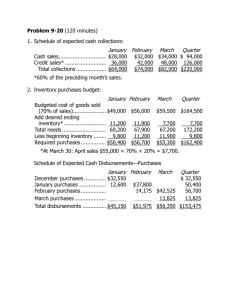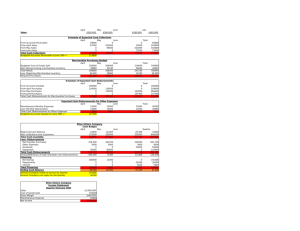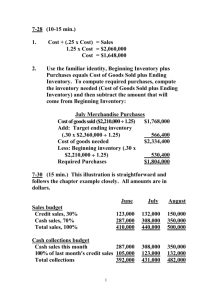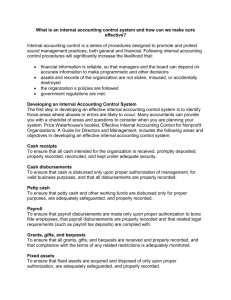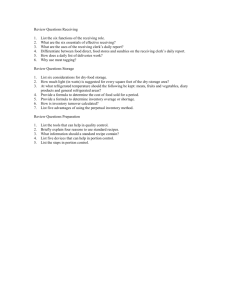Computer-Based Purchases and Cash Disbursements Applications
advertisement
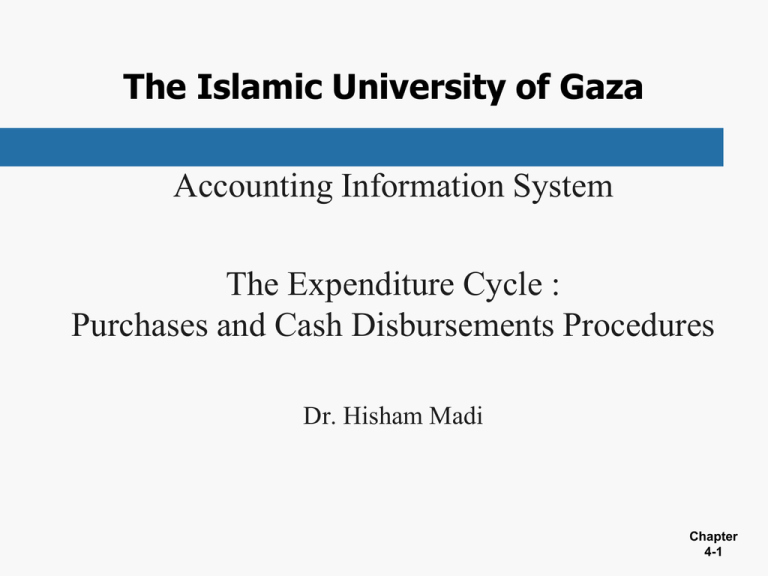
The Islamic University of Gaza Accounting Information System The Expenditure Cycle : Purchases and Cash Disbursements Procedures Dr. Hisham Madi Chapter 4-1 Computer-Based Purchases and Cash Disbursements Applications CBAS technology can be viewed as a continuum with two extremes: automation - use technology to improve efficiency and effectiveness reengineering – use technology to restructure business processes and firm organization Chapter 4-2 Computer-Based Purchases and Cash Disbursements Applications Automating Purchases Procedures Using Batch Processing Technology Data Processing Department: Step 1 The purchasing process begins in the data processing department, where the inventory control function is performed. When inventories are reduced the system determines if the affected items in the inventory subsidiary file have fallen to their reorder points. Chapter 4-3 Computer-Based Purchases and Cash Disbursements Applications Purchasing Department Alternative one System automatically prepares the PO documents and sends them to the purchasing department for review and signing. The purchasing agent then mails the approved POs to the vendors and distributes copies to other internal users. Alternative two Distributing the POs directly to the vendors and internal users, thus bypassing the purchasing department completely Chapter 4-4 Computer-Based Purchases and Cash Disbursements Applications Alternative three Electronic Data Interchange The computer systems of both the buying and selling companies are connected via a dedicated telecommunications link. Chapter 4-5 Computer-Based Purchases and Cash Disbursements Applications Data Processing Department: Step 2 a copy of the PO is sent to data processing and used to create a record in the open PO file. Receiving Department When the goods arrive from vendors, the receiving clerk prepares a receiving report and sends copies to the stores (with the goods), purchasing, AP, and data processing Data Processing Department: Step 3 The data processing department creates the receiving report file from data provided by the receiving report documents. Chapter 4-6 Computer-Based Purchases and Cash Disbursements Applications Data Processing Department: Step 3 Then a batch program updates the inventory subsidiary file from the receiving report file. The program removes the ‘‘On Order’’ flag from the updated inventory records and calculates batch totals of inventory receipts Accounts Payable When the AP clerk receives the supplier’s invoice, he or she reconciles it with the supporting documents that were previously placed in the AP pending file The clerk then prepares a voucher, files it in the open voucher file, and sends a copy of the voucher to data processing. Chapter 4-7 Computer-Based Purchases and Cash Disbursements Applications Data Processing Department: Step 4 The voucher file is created from the voucher documents. A batch program validates the voucher records against the valid vendor file and adds them to the voucher register Chapter 4-8 Computer-Based Cash Disbursements Data Processing Department the system scans for vouchers currently due Checks are printed for these items, and each check is recorded in the check register Records these checks in the check register Batch totals of closed AP and cash disbursements are prepared for the general ledger update procedure. Chapter 4-9 Computer-Based Cash Disbursements Cash Disbursements Department The cash disbursements clerk reconciles the checks with the transaction listing and submits the negotiable portion of the checks to management for signing. The checks are then mailed to the suppliers. One copy of each check is sent to AP Accounts Payable Department Upon receipt of the check copies, the AP clerk matches them with open vouchers Chapter 4-10 REENGINEERING THE PURCHASES/CASH DISBURSEMENTS SYSTEM Data Processing The following tasks are performed automatically. The inventory file is searched for items that have fallen to their reorder points. A record is entered in the purchase requisition file for each item to be replenished Requisitions are consolidated according to vendor number. Vendor mailing information is retrieved from the valid vendor file. Purchase orders are prepared and added to the open PO file. A transaction listing of purchase orders is sent to the purchasing Chapter department for review. 4-11 REENGINEERING THE PURCHASES/CASH DISBURSEMENTS SYSTEM Receiving Department the receiving clerk accesses the open PO file in real time by entering the PO number taken from the packing slip. Data Processing Quantities of items received are matched against the open PO record, and a Y value is placed in a logical field to indicate the receipt of inventories. A record is added to the receiving report file. The inventory subsidiary records are updated to reflect the receipt of the inventory items. Chapter 4-12 REENGINEERING THE PURCHASES/CASH DISBURSEMENTS SYSTEM The general ledger inventory control account is updated. The record is removed from the open PO file and added to the open AP file, and a due date for payment is established. Chapter 4-13 REENGINEERING THE PURCHASES/CASH DISBURSEMENTS SYSTEM Each day, the DUE DATE fields of the AP records are scanned for items due to be paid Checks are automatically printed, signed, and distributed to the mail room for mailing to vendor vendors receive payment by electronic funds transfer The payments are recorded in the check register file. Chapter 4-14 REENGINEERING THE PURCHASES/CASH DISBURSEMENTS SYSTEM Items paid are transferred from the open AP file to the closed AP file. The general ledger AP and cash accounts are updated. Reports detailing these transactions are transmitted via terminal to the AP and cash disbursements departments for management review and filing. Chapter 4-15 The Automated System Improving ability to manage inventory needs. Inventory requirements are detected as they arise and are processed automatically. As a result, the risks of accumulating excessive inventory or of running out of stock are reduced With this advantage, however, comes a control concern. Program errors or flawed inventory models can cause firms to find themselves suddenly inundated with inventories or desperately short of stock. Chapter 4-16 The Automated System Better Cash Management The automated system promotes effective cash management by scanning the voucher file daily for items due, thus avoiding early payments and missed due dates. By writing checks automatically, the firm reduces labor cost, saves processing time, and promotes accuracy Chapter 4-17 The Automated System To control against unauthorized payments voucher file should be validated by comparing the vendor number on the voucher against the valid vendor file. Time Lag. A lag exists between the arrival of goods in the receiving department and recording inventory receipts in the inventory file When sales clerks do not know the current status of Chapter inventory, sales may be lost 4-18 The Automated System Excessive Paper Documents All operations departments create documents, which are sent to data processing, and which data processing must then convert to magnetic media. Paper documents add costs because they must be purchased, stored, prepared, handled by internal mail carriers, and converted by data processing personnel Chapter 4-19 The Reengineered System it uses real-time procedures and direct access files to shorten the lag time in record keeping. It achieves a significant reduction in paper documents by using digital communications between departments and by digitally storing records Chapter 4-20 The Reengineered System Control Implications This system removes the physical separation between authorization and transaction processing. Computer programs authorize and process POs as well as authorize and issue checks to vendors. The system provides management with detailed transaction listings and summary reports Chapter 4-21 The Reengineered System Accounting Records And Access Controls. Advanced systems maintain accounting records on digital storage media, with little or no hard-copy backup. Sarbanes-Oxley legislation requires organization management to implement adequate control security measures to protect accounting records from unauthorized access and destruction Chapter 4-22
